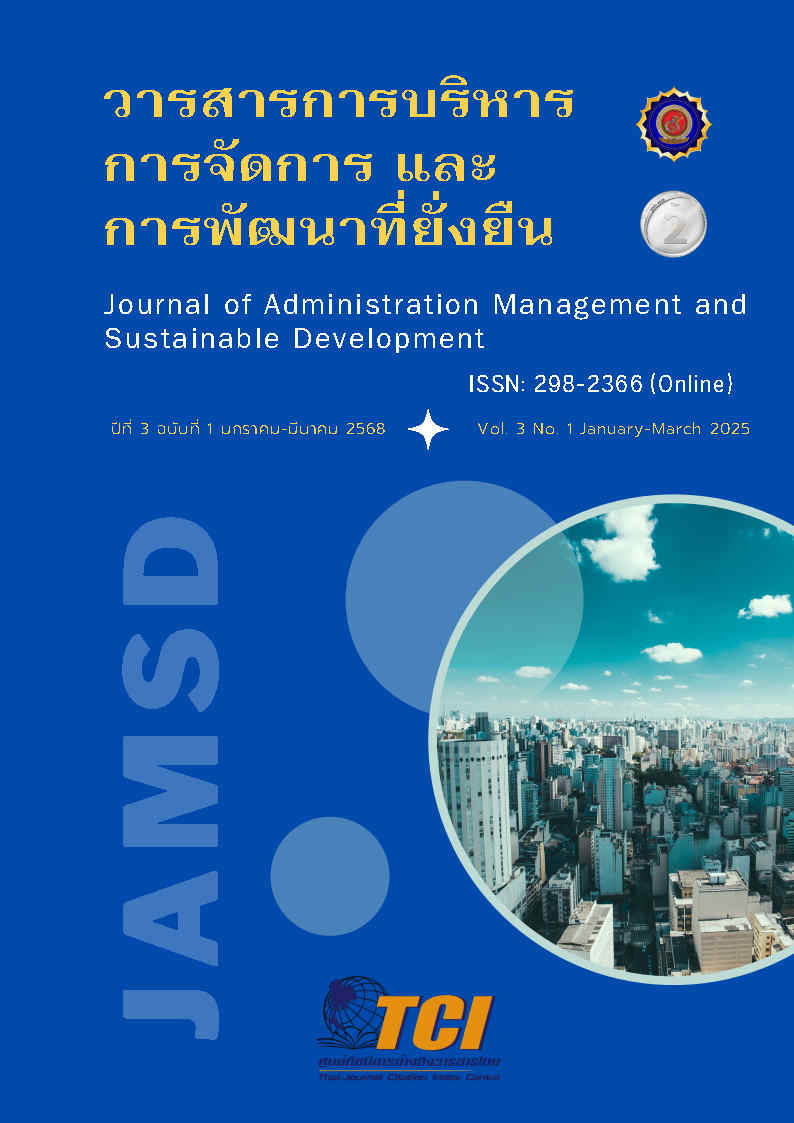From transparency to trust: Key determinants of corruption perception in Thailand
Keywords:
public perception, government transparency, media, social media, law enforcement, citizen participationAbstract
This study examines public perceptions of corruption in Thailand using a qualitative research approach, incorporating in-depth interviews and thematic analysis to identify key influencing factors. Participants were selected through purposive sampling, including citizens with government service experience, policymakers, journalists specializing in corruption, and legal experts in anti-corruption efforts. The findings indicate that factors shaping corruption perceptions include government transparency, law enforcement, citizen participation, and the media’s role. Additionally, social media plays a crucial role in disseminating corruption-related information, though it can sometimes lead to exaggerated perceptions or misinformation, affecting public trust in the government. The insights from this study provide practical implications for enhancing government transparency through improved information disclosure policies, leveraging technology to minimize corruption risks, and strengthening the role of media and civil society in monitoring government accountability.
References
Achim, M. V., & Borlea, S. N. (2018). The impact of corruption on population health. Population Health Management, 21(1), 26-38. https://doi.org/10.1089/pop.2017.0063
Awale, A. A., & Kulmie, D. A. (2024). Public employees’ views on corruption and fina0ncial crimes: A perceptual study. Journal of Asian Scientific Research, 14(4), 612-626.
Besley, T., & Prat, A. (2006). Handcuffs for the grabbing hand? Media capture and government accountability. American Economic Review, 96(3), 720-736. https://doi.org/10.1257/aer.96.3.720
Birdsall, N., Kenny, C., & Diofasi, A. (2018). What drives citizen perceptions of government corruption? National income, petty bribe payments and the unknown. International Economic Association Series, in: Kaushik Basu & Tito Cordella (ed.), Institutions, Governance and the Control of Corruption, chapter 10, pages 285-334, Palgrave Macmillan.
Braun, V., & Clarke, V. (2019). Reflecting on reflexive thematic analysis. Qualitative Research in Sport, Exercise and Health, 11(4), 589-597. https://doi.org/10.1080/2159676X.2019.1628806
Edelman Trust Barometer. (2023). 2023 Edelman Trust Report: The Role of Transparency in Trust Building. Retrieved from https://www.edelman.com/trust-barometer.
Hübler, O., Koch, M., Menkhoff, L., & Schmidt, U. (2021). Corruption and cheating: Evidence from rural Thailand. World Development, 145, 105526. https://doi.org/10.1016/j.worlddev.2021.105526.
Hussain, T., Maitlo, S., Raza-ul-Mustafa, A., & Mujahid, H. (2022). Corruption, governance, and government revenue. Journal of History and Social Sciences, 13(2), 122-133.
Ionescu, L. (2013). Perceptions of corruption in emerging economies. Economics, Management, and Financial Markets, 8(1), 136-141.
Khoman, S. (2015). Corruption, Transactions Costs, and Network Relationships: Governance Challenges for Thailand. In Sustainable Economic Development (pp. 215-235). Academic Press.
Kolstad, I., & Wiig, A. (2009). Is transparency the key to reducing corruption in resource-rich countries? World Development, 37(3), 521-532. https://doi.org/10.1016/j.worlddev.2008.07.002.
Ma, J., Guo, B., & Yu, Y. (2022). Perception of official corruption, satisfaction with government performance, and subjective wellbeing—An empirical study from China. Frontiers in Psychology, 13, 748704. https://doi.org/10.3389/fpsyg.2022.748704.
Muktiyanto, A., Dwiyani, R., Hartati, N., Perdana, H. D., & Possumah, B. T. (2019). Control combating corruption: A governance model from Indonesians' perspective. Journal of Southwest Jiaotong University, 54(5), 1-11.
Munteanu, I., Ileanu, B. V., Florea, I. O., & Aivaz, K. A. (2024). Corruption perceptions in the Schengen Zone and their relation to education, economic performance, and governance. PLOS One, 19(7), e0301424. https://doi.org/10.1371/journal.pone.0301424.
Mutebi, A. M. (2008). Explaining the Failure of Thailand's Anti-corruption Regime. Development and Change, 39(1), 147-171. https://doi.org/10.1111/j.1467-7660.2008.00472.x.
Pannasil, P., Phosing, P., & Kenaphoom, S. (2016). Corruption in the Thai Bureaucracy: The Protection and Solution Approach. Journal of MCU Peace Studies, 4(2), 326-340.
Prateeppornnarong, D. (2020). Fighting corruption while having hands tied: A case study of Thailand’s public sector anti-corruption commission. Journal of Asian and African Studies, 56(2), 320-334. https://doi.org/10.1177/0021909620926529.
Rose-Ackerman, S. (1978). Corruption: A Study in Political Economy. Cambridge: Academic Press. https://doi.org/10.1016/B978-0-12-596350-3.50005-3.
Stapenhurst, R. (2000). The media's role in curbing corruption. World Bank Institute. Retrieved from https://documents1.worldbank.org/curated/zh/893191468766225068/pdf/multi-page.pdf.
Transparency International. (2023). Corruption Perceptions Index 2023. Retrieved from https://www.transparency.org/en/cpi/2023.
Treisman, D. (2007). What have we learned about the causes of corruption from ten years of cross-national empirical research? Annual Review of Political Science, 10(1), 211-244.
Zhang, Y. (2022). The relationship between corruption perception and depression: A multiple mediation model. Psychology Research and Behavior Management, 2022(15), 1943-1954. https://doi.org/10.2147/PRBM.S374839.





